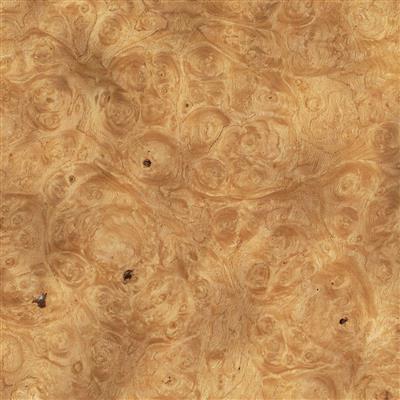Veneer Chestnut Burl 0.60 mm
The grained chestnut has a brown-yellow, slightly cognac-coloured hue, which gives the wood a warm and friendly appearance. Indicated circles and swirls dominate the picture of this very rare wood. Small, very fine and hardly distinguishable burls are scattered throughout the wood.
Trade names and other names
German: Kastanie Maser, sweet chestnut burl
English: Chestnut burl
French: Loupe de Châtaigner
Italian: Radica di Castagno
Spanish: n.a.
Dutch: n.a.
Portuguese: n.a.
Arabic: n.a.
Chinese: 栗木树榴
Available veneer thicknesses
0.6 mm, other thicknesses on request
Occurrence
The chestnut tree originates from Asia and was already cultivated in Europe in ancient times, so that today the main occurrence is still in the countries of the Mediterranean area, especially in Portugal, Spain, Italy, the Balkans, North Africa and Asia Minor up to the Caspian Sea. North of the Alps, the chestnut is found especially in Switzerland, southern Germany, southern and western France and southern England.
Tree trunk and bark
Chestnut grows up to 25m high and with diameters of up to 1.2m. As a result of the strong cane growth, the trunk is rarely more than 10 to 12m knot-free in chestnut. The bark is glossy reddish brown with white lenticels on one-year-old branches, olive brown on perennial branches, spotted by lichen, and shows bark formation after the 15th year. It is grey-brown, longitudinally cracked and contains about 12% tannic acid.
Characteristics and wood colour
Pores ring-shaped and large. Annual rings very distinct. The large pores form clear needle cracks in longitudinal section. Decorative wood with high tannic acid content. The sapwood and heartwood of the sweet chestnut are well separated. The sapwood is very narrow and dirty yellow-white, while the heartwood is light brown and shiny when fresh, darkening later.
| Category | Veneers |
| Product group | Burl veneers |
| Thicknesses | 0.60 mm |
| Weight kg/m2 | 0.330 |
| Specie | Sweet Chestnut burl |
| Botanical name | Castanea sativa |
| Wood type | Hardwood |
| Main occurrence | Europe |
| Wood origin | Germany | France | Italy | Czech Republic |
| Manufacturing/origin | Spain |
| Certification | not certified |
| Colour | red brown |
| Hue | medium colour |
| Use | interior | Automotive expansion |
| Customs tariff number | 44089000 |
| Packaging | in bundle, approx. 24-32 sheets |
| Items on stock | yes |
| Date of delivery | approx. 3 - 6 working days |
| Postal shipping | nein |

 Deutsch
Deutsch
 Français
Français
 Italiano
Italiano



